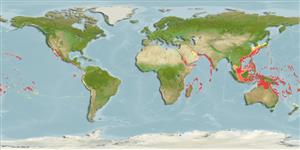Common names from other countries
Environment: milieu / climate zone / depth range / distribution range
Οικολογία
; εύρος βάθους 10 - 150 m (Ref. 93550). Tropical
Indo-Pacific and the Mediterranean: Mediterranean to Midway Island and Easter and Salas y Gómez islands.
Length at first maturity / Μέγεθος / Βάρος / Age
Maturity: Lm ? range ? - ? cm Max length : 2.2 cm TL αρσενικό/απροσδιόριστο; (Ref. 2922)
Attached to rocks (Ref. 75840).
Life cycle and mating behavior
Γεννητική Ωρίμανση | Αναπαραγωγή | Γεννοβολία | Αβγά | Γονιμότητα | Προνύμφες
Members of the class Bivalvia are mostly gonochoric, some are protandric hermaphrodites. Life cycle: Embryos develop into free-swimming trocophore larvae, succeeded by the bivalve veliger, resembling a miniature clam.
Taylor, J.D. and E.A. Glover. 2004. (Ref. 8021)
IUCN Red List Status (Ref. 130435)
CITES status (Ref. 108899)
Not Evaluated
Not Evaluated
Threat to humans
Harmless
Human uses
| FishSource |
Εργαλεία
Περισσότερες πληροφορίες
Age/Size
Αύξηση
Length-weight
Length-length
Μορφολογία
Προνύμφες
Αφθονία
Διαδικτυακές πηγές
Estimates based on models
Preferred temperature
(Ref.
115969): 23 - 28.6, mean 26.6 (based on 220 cells).
Vulnerability
Low vulnerability (10 of 100).
